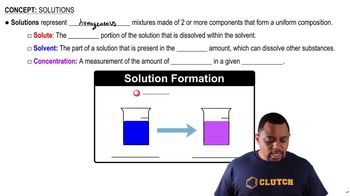Here are the essential concepts you must grasp in order to answer the question correctly.
Osmolality
Osmolality refers to the concentration of solute particles in a solution, expressed in osmoles per liter (osmol/L). It is crucial for understanding how solutions affect cell behavior, particularly in biological contexts. An isotonic solution has the same osmolality as body fluids, preventing net movement of water across cell membranes.
Recommended video:
Isotonic Solution
An isotonic solution is one that has an equal concentration of solutes compared to another solution, typically body fluids. This balance ensures that cells neither swell nor shrink due to osmosis, maintaining cellular integrity. In medical applications, isotonic solutions are often used for intravenous fluids to avoid cellular damage.
Recommended video:
Molarity and Mass Calculation
Molarity is a measure of concentration defined as moles of solute per liter of solution. To prepare a specific volume of an isotonic solution, one must calculate the required mass of solute (in this case, KCl) using its molar mass and the desired molarity. This involves converting the volume of the solution to liters and applying the formula: mass = molarity × volume × molar mass.
Recommended video:
 Verified step by step guidance
Verified step by step guidance


